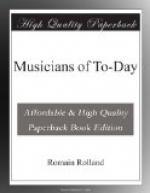Zarathustra shows the progress of scornful individualism in Strauss—“the spirit that hates the dogs of the populace and all that abortive and gloomy breed; the spirit of wild laughter that dances like a tempest as gaily on marshes and sadness as it does in fields."[176] That spirit laughs at itself and at its idealism in the Don Quixote of 1897, fantastische Variationen uber ein Thema ritterlichen Charakters ("Don Quixote, fantastic variations on a theme of knightly character"), op. 35; and that symphony marks, I think, the extreme point to which programme music may be carried. In no other work does Strauss give better proof of his prodigious cleverness, intelligence, and wit; and I say sincerely that there is not a work where so much force is expended with so great a loss for the sake of a game and a musical joke which lasts forty-five minutes, and has given the author, the executants, and the public a good deal of tiring work. These symphonic poems are most difficult to play on account of the complexity, the independence, and the fantastic caprices of the different parts. Judge for yourself what the author expects to get out of the music by these few extracts from the programme:—
[Footnote 176: Nietzsche, Zarathustra.]
The introduction represents Don Quixote buried in books of chivalrous romance; and we have to see in the music, as we do in little Flemish and Dutch pictures, not only Don Quixote’s features, but the words of the books he reads. Sometimes it is the story of a knight who is righting a giant, sometimes the adventures of a knight-errant who has dedicated himself to the services of a lady, sometimes it is a nobleman who has given his life in fulfilment of a vow to atone for his sins. Don Quixote’s mind becomes confused (and our own with it) over all these stories; he is quite distracted. He leaves home in company with his squire. The two figures are drawn with great spirit; the one is an old Spaniard, stiff, languishing, distrustful, a bit of a poet, rather undecided in his opinions but obstinate when his mind is once made up; the other is a fat, jovial peasant, a cunning fellow, given to repeating himself in a waggish way and quoting droll proverbs—translated in the music by short-winded phrases that always return to the point they started from. The adventures begin. Here are the windmills (trills from the violins and wood wind), and the bleating army of the grand emperor, Alifanfaron (tremolos from the wood wind); and here, in the third variation, is a dialogue between the knight and his squire, from which we are to guess that Sancho questions his master on the advantages of a chivalrous life, for they seem to him doubtful. Don Quixote talks to him of glory and honour; but Sancho has no thought for it. In reply to these grand words he urges the superiority of sure profits, fat meals, and sounding money. Then the adventures begin again. The two companions fly through the air on wooden horses; and the illusion of this giddy voyage is given by chromatic passages on the flutes, harps, kettledrums, and a “windmachine,” while “the tremolo of the double basses on the key-note shows that the horses have never left the earth."[177]




